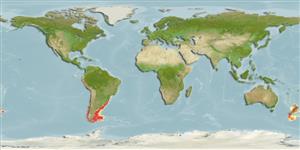Common names from other countries
Environment: milieu / climate zone / depth range / distribution range
экология
батидемерсальный. Tropical; 0°N - 90°S, 180°W - 180°E
Southeast Pacific and Southwest Atlantic: South America. Tropical to temperate.
Length at first maturity / Size / Вес / Возраст
Maturity: Lm ? range ? - ? cm Max length : 260 cm TL самец/пол неопределен; (Ref. 1394); 220 cm TL (female); наибольший вес (опубликованные данные): 350.0 kg (Ref. 1394); наибольший вес (опубликованные данные): 350.0 kg
Found over the continental shelf and slope. Occurs in deep waters, and also venture into freshwaters in rivers and around glaciers. Feeds on many species of benthic and pelagic fishes, and invertebrates (i.e. lobster, krill, squid, octopus, and jellyfish), and occasionally penguins and young South American seals) (Ref. 1394). Preyed upon by a sevengill shark (Ref. 8910). Found over the continental shelf and slope. Occurs in deep waters, and also venture into freshwaters in rivers and around glaciers. Feeds on many species of benthic and pelagic fishes, and invertebrates (i.e. lobster, krill, squid, octopus, and jellyfish), and occasionally penguins and young South American seals) (Ref. 1394).
Основная ссылка
ссылки | координатор | соавторы
Jefferson, T.A., S. Leatherwood and M.A. Webber. 1993. (Ref. 1394)
Статус Красного Списка МСОП (Ref. 130435)
Статус СИТЕС (Ref. 108899)
Not Evaluated
Использование человеком
рыболовство: коммерческий
FAO - рыболовство: landings, Видовой профиль | FishSource | Sea Around Us
инструменты
дополнительная информация
ресурсы в Интернет
Estimates based on models
Preferred temperature
(Ref.
115969): 6.3 - 15.6, mean 9.9 (based on 922 cells).
устойчивость к внешним воздействиям
высокий, минимальное время удвоения популяции до 15 месяцев (K=0.31-0.31).
Уязвимость
Moderate to high vulnerability (51 of 100).
Категория цены
Unknown.
